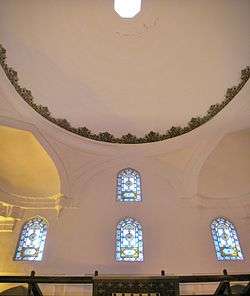Haseki Hürrem Sultan Hamamı
| Ayasofya Hürrem Sultan Hamamı | |
|---|---|
 Ayasofya Hürrem Sultan Hamamı | |
| General information | |
| Location | Fatih, Istanbul |
| Address | Cankurtaran Mah. Ayasofya Meydanı No:2 |
| Coordinates | 41°00′26″N 28°58′45″E / 41.00732°N 28.97928°E |
| Opened | 1556 |
| Renovated | May 2011 |
| Owner | Metropolitan Municipality of Istanbul |
| Management | Haseki Tourism Group |
| Other information | |
| Facilities | Steam bath, peeling and soap massage |
| Website | |
|
www | |
The Haseki Hürrem Sultan Hamamı (literally: Bath-house of Haseki Hürrem Sultan), aka Ayasofya Haseki Hamamı, is a Turkish hamam that was commissioned by the Ottoman Sultan Suleiman I's consort, Hürrem Sultan, and constructed by Mimar Sinan during the 16th century in Istanbul. It was built on the site of historical Baths of Zeuxippus for the religious community of the nearby Hagia Sophia.
Architecture
The public bath-house was constructed as a charity building by architect Mimar Sinan in 1556. The 75 m (246 ft) long structure is designed in the style of classical Ottoman baths having two symmetrical separate sections for males and females. Both sections, situated in north-south direction, are on the same axis that was a novelty in the Turkish bath architecture. The men's section is in the north while the women's part is in the south.[1]

The exterior walls are built in courses of one cut stone and two bricks. The changing room of the men's section has four pointed-arch stained-glass windows above in the facade and the women's changing room has three windows.
The entrances of both sections are apart. The entrance to the men's section is in the north and the women's in the west. Unlike in the architecture of other Turkish baths, there is a stoa with a dome in the center of the men's section's front side. The roofs of the dome and the stoa are decorated with bricks, and covered by lead sheet material. A red and a white palmette with a golden epigraph on green ground ornament the pointed arch of the monumental entrance door.
Each section consists of three basic, interconnected rooms, namely the changing room (soyunmalık), the intermediate cool room (soğukluk, frigidarium) and the hot room (sıcaklık, caldarium). The hot rooms of the two sections are adjacent while the changing rooms are situated at the both end of the axis. The rooms are arranged in the order of the changing room, cool room and hot room of the men's section, followed by the hot room, cool room and the changing room of the women's section.[1]

The men's changing room has a rectangular shape and is covered with a dome, which is surrounded by frieze of zigzag-formed leaves in ablaq decorative technique. The room has pointed-arch niches in each of its four sides. On one side of the cool room, roofed with three domes, toilets are situated, and on the other side a shaving room. A door leads in the cross-shaped hot room, which has four loggias with fountains in the corners, and four self-contained cubicles for retreat (halvet) under a small dome. In the center of the hot room, a large octagonal marble-stone table called göbek taşı (literally: tummy stone) is situated, which the bathers lie on. It is known that this part was formerly decorated with mosaics. The large dome of the hot room, which sits on the octagonal-shaped walls, has small glass windows to create a half-light from top. The women's section has the same architectural plan as the men's side while its changing room however is smaller.
Restoration
The building stood closed a long time, was used as a warehouse sometime and underwent a restoration in 1957–1958.[1]
In 2007, Istanbul city authorities decided to return the hamam to its original use after a 105-year hiatus and launched a tender for its restoration, won by a tourism development group. After a three-year-long restoration project that began in 2008 and cost US$11 million, the bath-house re-gained its glory with its opening in May 2011.[1] It is now operated by Haseki Tourism Group. Hamam services start from "Pir-i Pak" package of €80 for the customary steam bath, peeling and soap massage.
References
- 1 2 3 4 "Haseki Hamamı" (in Turkish). Istanbul Net. Retrieved 2014-01-17.
External links
- Official website
- Haseki Bath House
- Hürrem Sultan Hamam Coming 2011
- Hürrem Sultan Hamam (Bath)
- house of Sultan's favourite reopens in Istanbul
Literature
| Wikimedia Commons has media related to Haseki Hürrem Sultan Hamamı. |
- Yılmazkaya, Orhan (2005). Turkish Baths: A Light onto a Tradition and Culture. Istanbul: Çitlembik Publications. ISBN 978-9756663806.
- Kocaeli University Faculty of Architecture In 2008-2011 Instructor Re-Bath of Architects Tevfik İlter Executed For Use Hamam (Bath)